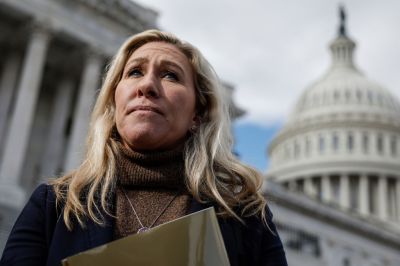“America first!” they shout. “Also: Death to the United States!”
The politics of “national divorce” are distinctly daffy.
It should not surprise us very much that House Republicans under the leadership of the hobbled Trump sycophant Kevin McCarthy have installed on the Homeland Security Committee such a figure as Marjorie Taylor Greene, who likes to call herself a “patriot.” She also calls for the political annihilation of the United States of America, dividing the “red states” from the “blue states” as though the entire country were not composed of conservative-leaning “red” rural areas dotted by progressive-leaning “blue” cities. The most predictable thing in the world was that the people who cheered the attempted coup d’état of January 6 would continue attempting to overthrow the government and void the Constitution.
Why call it “national divorce”? There already is something a lot like divorce for people who have come to believe they have irreconcilable differences with their native country: It is called “emigration,” and, for all their bellyaching, dissatisfied Americans very rarely do it. We should instead call this imbecilic idea—which is not really an idea or a policy proposal as much as it is a temper tantrum—what it actually is (or would be) and use the term that carries with it some historic weight: partition.
Until its independence, what used to be called “India” comprised what are today three countries: The Republic of India, the Islamic Republic of Pakistan, and the People’s Republic of Bangladesh, formerly East Pakistan. The great division in India at the time was between Hindus, who constituted the majority of the population, and Muslims, who constituted a minority but a large one. As with the Catholics and Protestants of Northern Ireland, the political leadership of the two religious factions was not especially religious: The most important Muslim leader was Muhammad Ali Jinnah, a thoroughly secular nationalist who approached Islam mainly as a bulwark of cultural identity (much like the so-called cultural Christians of the American right) while his opposite number, Jawaharlal Nehru, was an assertively secular Hindu who at times seemed to be much more interested in Buddhism than in Hinduism or Islam. (Jinnah would become the first governor-general of Pakistan, Nehru the first prime minister of India.) The most famous figure of the era, Mohandas K. Gandhi, was deeply pious in his way but by no means orthodox—in the end, he was assassinated by a Hindu fanatic after leading a multifaith prayer meeting.
The Partition of India—which brought about the deaths of as many as 2 million people and the displacement of tens of millions—is a complex story and should not be oversimplified. That being written, for our purposes it is worth understanding that one of the factors (not the only one) that led to partition was the political self-interest of Muhammad Ali Jinnah and those around him who believed that their own ambitions would be more easily realized in a smaller Muslim-majority country than in a larger Hindu-majority country. Their plan was (or should have been) obviously unworkable from the beginning in that practically every city and village in India was home to both Muslims and Hindus and that the Muslim-majority areas comprised two non-contiguous masses on either side of what is today India. East Pakistan, what is today Bangladesh, was culturally distinct from what is today Pakistan, and Pakistan itself is a synthetic creation. (The PAK in Pakistan began as an acronym for Punjab, Afghania, Kashmir, with Sindh and Baluchistan represented in the suffix.) East Pakistan went its own way in 1971. Pakistan today is, of course, a basket-case, and, like Bangladesh, it remains very poor: Either country would have to experience some radical economic improvement before it attained the standard of living found in, say, Guatemala. Nehru observed at the time of Jinnah’s death: “He succeeded in his quest and gained his objective, but at what a cost and with what a difference from what he had imagined.”
What a difference from what they had imagined—that is very often the case. I do not think that a post-partition America would find Americans enduring Pakistani standards of living in either Wyoming or Connecticut, because Americans are Americans and would continue to behave like Americans, for better and for worse, whatever the imbeciles might try to do to the map. This isn’t an accidental country—it is the country it is because of the people who live here.
And that, of course, is the point.
Speaking about the prospect of “national divorce” on his radio program, Matt Walsh voiced what I fear is a typical view on the right: He rejects the idea on logistical grounds but is not entirely unsympathetic to it on cultural ones. “Can you name one shared value that binds Americans together?” he asks. “There really is nothing. ... In what sense are we a people? The only thing is that we all happen to live within the same borders.” That is, of course, foolishness. If we could force Matt Walsh and Alexandria Ocasio-Cortez to live as neighbors in a village in rural Pakistan (and I do like the idea!), they would soon find out that they not only have a great deal in common but that as a cultural matter they have so much in common that they are very nearly identical. They would stick out—and stick together—for obvious reasons. Put them on a farm in Peru and you’d get the same result. If you could build a time machine and put them together in a Welsh or Scottish village in the 1950s, the results would be precisely the same.
Walsh’s insistence that there is nothing that binds Americans together is another way of saying that there is no such thing as an American culture, which, of course, there is. It is just that the American culture is not what entrepreneurial partisans such as Walsh on his side or Ocasio-Cortez on her side wish it were. This, too, you could discover, by making them live as neighbors in, say, one of the nicer neighborhoods in London, where they would find that they had a great deal more in common with their neighbors and would not be so obviously two-of-a-kind, two nearly identical fish out of water. That is because American culture is, among other things, urban, liberal, and Anglophone, and it is these deeply rather than incidentally. Right-wing partisans valorize rural America (though damned few of them live there) and abominate the cities, while left-wing partisans spit accusations of racism at any suggestion that our British heritage is an indelible part of the American identity in a way that the surviving influence of the Spanish Empire is not. And everybody hates liberalism, or “neoliberalism,” if you must. Neither political tribe finds much satisfaction in the United States as it actually is and in Americans as they actually are. That is because the United States of America is a real place full of real people rather than an exercise in ideological (more genuinely tribal) wish-fulfillment.
History is full of little ironies: Among the first generation of Indian nationalists, there were relatively few foreign-educated leaders. But the major figures of the next generation of Indian nationalists—the ones who actually secured independence from the British—had something in common: They received legal educations in London, Gandhi and Nehru at Inner Temple (Nehru attended Cambridge before that) and Jinnah at Lincoln’s Inn. All three were born within 20 years of one another. They read the same books, knew the same people, went to the same parties, wrote for the same journals, and in each of those endeavors participated in a tiny, rarefied clique that necessarily excluded about 99.993 percent of the people on whose behalf they proposed to act. They were nationalists in the most straightforward sense, and they were all what our self-proclaimed nationalists profess to detest: members of a cosmopolitan elite. India’s current prime minister, the increasingly autocratic Narendra Modi, makes a point of not speaking one of the two languages in which his country’s constitution was written—English, though he is perfectly capable of speaking it.
(When I lived in India in the 1990s, the prime minister at the time, H.D. Deve Gowda, did not speak Hindi, and, as I utterly failed in my own attempt to learn the language, I sympathized.)
The problem for would-be secessionists on the right can be seen, in concentrated form, right where Matt Walsh lives: in Nashville, where Ben Shapiro and his partners moved the Daily Wire a while back. Tennessee is a relatively rightist state (Donald Trump won 60 percent of the vote there in 2020), but Republicans might as well not exist in Nashville. In fact, Republicans did not even bother contesting most of the city elections there in 2022. Republicans did manage to dilute the city’s political strength some by redrawing the lines of the 5th Congressional District, but as for persuading city residents of the wisdom and desirability of their policies, Republicans have abandoned the field. And not only in Nashville: In the last New York City mayoral race, the Republicans ran Curtis Sliwa of the Guardian Angels, an unserious candidate who barely won one vote in four votes. In this year’s mayoral race in Dallas, the incumbent, former Democratic state legislator Eric Johnson, will run unopposed. (The race is officially nonpartisan, but—you know.) For all that talk about “fighting” and “winning,” Republicans aren’t even in a lot of races that matter—not only in California and New York but in Texas and Tennessee. And this isn’t only a municipal question: Texas has 254 counties, but the majority of the people live in eight counties that voted for Joe Biden in the 2020 presidential election.
Even if Texas were to secede from the so-called blue states (it is a very popular myth that Texas reserves a legal right under treaty to revert to its prior status as an independent republic) the real question could be whether something we could still call “Texas” could secede from Austin, Dallas, San Antonio, Houston, El Paso, nine-tenths of the Rio Grande Valley, a few neighborhoods in Lubbock and Amarillo—and then maybe flip a coin for Fort Worth.
Of course, “national divorce” is silly talk, but Marjorie Taylor Greene is still a member of the House of Representatives who has the ear of the speaker of the House and sits on the Homeland Security Committee in spite of her stated desire to implement a program that would—let us be plain about this—obliterate that homeland to such an extent that it ceases to exist as the United States of America. Destroying the United States as such would not be an unhappy side effect of this policy—it is the policy.
I do not blame Marjorie Taylor Greene for being what she is any more than I blame an oyster for not being Itzhak Perlman. The same is true for Matt Gaetz, Lauren Boebert, George Santos, and the rest of the Republican clown show. I do blame the people who have benefited politically and financially from elevating these lunatics and grifters and for putting them in a position that obliges us to worry about their proposal to smash the country to bits in a tantrum.






Please note that we at The Dispatch hold ourselves, our work, and our commenters to a higher standard than other places on the internet. We welcome comments that foster genuine debate or discussion—including comments critical of us or our work—but responses that include ad hominem attacks on fellow Dispatch members or are intended to stoke fear and anger may be moderated.
With your membership, you only have the ability to comment on The Morning Dispatch articles. Consider upgrading to join the conversation everywhere.